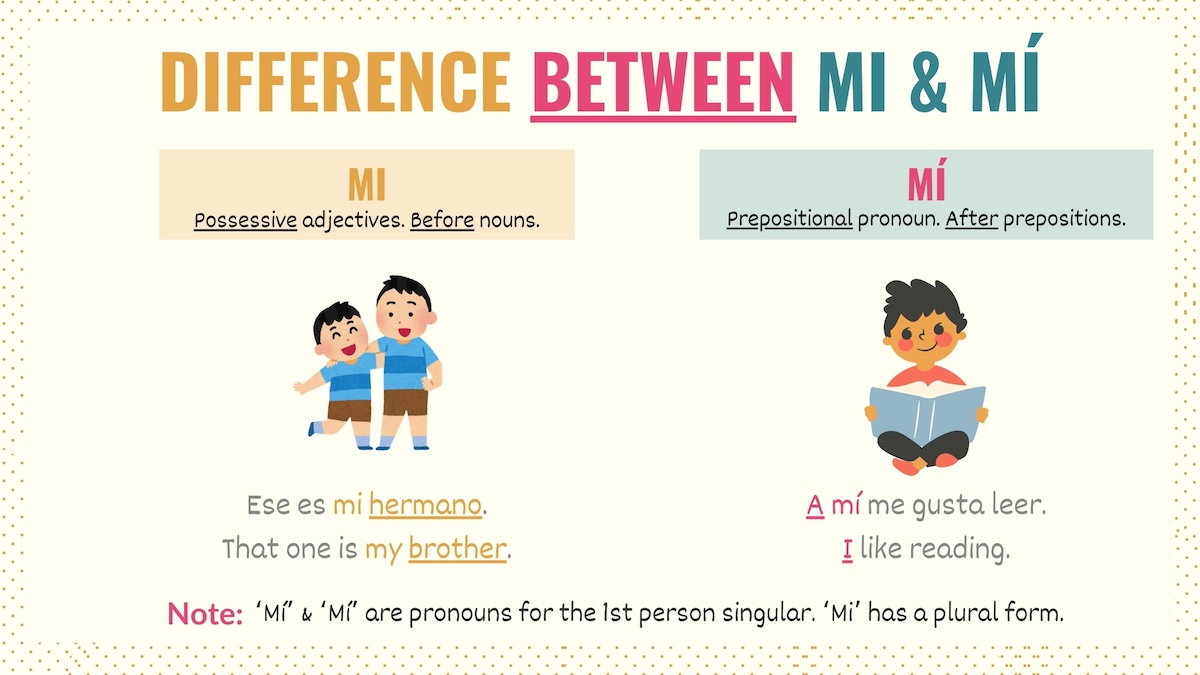
Mi in Spanish 101: Mi vs Mí vs Me vs Yo – Tips + Examples
There is a significant difference in the pronouns mi vs mí. Mi is a possessive adjective that works in front of singular nouns, and it means ‘my’. Mí, with an accent, is a pronoun that is placed after prepositions in Spanish. These words should not be confused with the object pronoun me.

Mi in Spanish: Key Points
‘Yo’, ‘mi’, ‘mí’, and ‘me’ are different types of Spanish pronouns for the first person singular. However, they all have different functions. Here are some roles to keep in mind:
- As a possessive adjective, mi (without accent) indicates possession or relationships.
- It’s placed before singular nouns, and has a plural form.
- Mí with an accent is a prepositional pronoun and is placed after most prepositions -para mí, a mí, por mí, etc.
- Me is an object pronoun and communicates that the first person singular is the object of the sentence.
- It can be reflexive if the subject performs the action on itself.
- It works as a direct object pronoun if someone else performs the action on this person.
- Me is an indirect object pronoun when the person is affected or benefited by the action.
- As a subject pronoun, yo replaces the subject of the sentence - the person who performs the action.
In the following sections, you’ll learn the specific situations where you must use each one of these Spanish words.
Mi vs Mí
Mi vs mí are distinguished by the absence or presence of an accent mark. The accent not only indicates a difference in pronunciation, but also changes these words’ meanings.
Mi without an accent is the singular Spanish possessive adjective for ‘yo’. As a result, it indicates that something belongs to this pronoun. A key characteristic of mi is that it must be placed before a singular noun.
Mi + [singular noun]
Mi mochila está sucia. My backpack is dirty.
Ese es mi hermano. That one is my brother.
Dejé mi cartera en tu carro. I left my wallet in your car.
Katie y Ben son mis amigos. Katie and Ben are my friends.
As shown in the previous example, mi has a plural form (mis).
Take Note: When the context is clear and you can omit the belonging or relationship, you can use the possessive adjective mío instead of mi - “esa es mía”.
Mí with an accent is a prepositional pronoun in Spanish. In other words, this is a pronoun we use instead of ‘yo’ and that we must place after most prepositions.
[Preposition] + mí
A mí me gusta leer. I like reading.
¿Hiciste ese pastel para mí? ¡Qué lindo! Did you make that cake for me? How nice!
Gracias a mí, mis amigas encontraron sus bolsas. Thanks to me, my friends found their bags.

Take Note: Like mi vs mí, there are other sets of words whose meanings are affected by accent marks. Some examples are si vs sí, te vs té, and el vs él.
When to Use Me in Spanish
In Spanish, me is an object pronoun. It expresses that the first person singular (yo) is the object of a sentence. Depending on its role, me can be an indirect, direct, or reflexive pronoun.
As a reflexive pronoun, me communicates that I’m both the subject and object of the action. In other words, it indicates that I perform the action on myself. For example:
Yo me cepillo el cabello. I brush my hair.
Me desperté muy temprano. I woke up very early.
¿Me pongo el vestido que me regalaste? Should I wear the dress you gave me?
On the other hand, me, as a direct object pronoun, indicates that the first person singular is the target of the action, the person to whom we do something.
¿Sí me quieres? Do you love me?
Mi prima me maquilla. My cousin puts makeup on me.
Laura me deja en la oficina todos los días. Laura leaves me in the office everyday.
When working as a Spanish indirect object pronoun, me communicates that this person is affected or benefited by the action.
Dime qué dijo. Tell me what she said.
¿Me compras esas flores? Can you buy me those flowers?
¿Me pongo el vestido que me regalaste? Should Iwear the dress you gave me?

Using the Pronoun Yo
Yo is a subject pronoun for the first person singular and indicates who performs the action of a sentence. For example:
Yo soy maestra. I am a teacher.
¿Tú cuándo puedes? Yo puedo el domingo. When can you do it? I can on Sunday.
Yo me baño en las mañanas después de correr. I shower in the morning after running.
Take Note: Due to the verb conjugation, subject pronouns in Spanish can be omitted without affecting the meaning of the sentence. This is not the case with ‘mi’, ‘mí’, and ‘me’, which are mandatory to keep the meaning of a statement.
Watch the Video Lesson
Link nội dung: https://truyenhay.edu.vn/mi-a37537.html